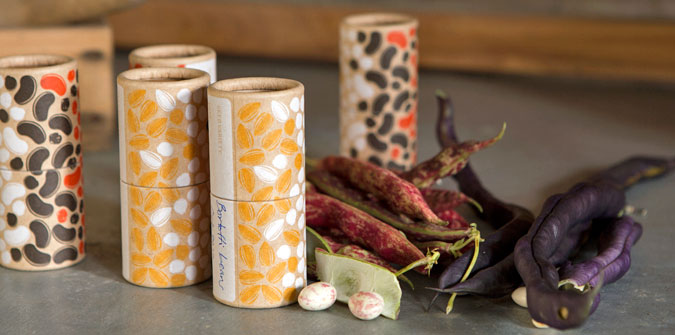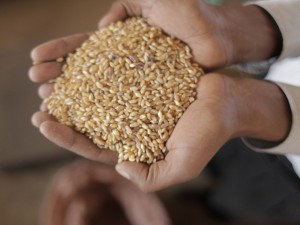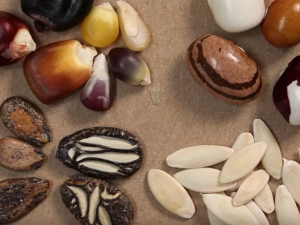Seed saving: a great idea, and now’s the time to start thinking about it

One of the pleasures of autumn is gathering seeds. It’s a hopeful optimistic act that conjures up thoughts of the next spring, and by and large it’s pretty simple act. For most vegetables, all that is needed is for the fruit to be left on the plant until it’s overripe, and for the seed to be then cleaned and dried. For some seeds though there are a few challenges, not least of which is trying to produce a child which resembles the parent!

Beans
Beans are the easiest seeds to collect. In most cases they can be left on the plant to dry before being podded and then left somewhere airy to dry. The recent wet weather however is a challenge as too much rain during seed maturation lowers the viability and storage life of the stored seed. You should still achieve at least 50% germination though.

Cabbages
Cabbage seed is more difficult to collect as different members of the same cabbage family (for example broccoli, Brussels sprouts, cauliflower and cabbage) will cross-pollinate, so for the seed to grow ‘true’ to its parents it needs to be isolated. This means either growing the varieties well away from each other (pollen can travel over a mile!), or isolating individual plants or flowers with bags. Furthermore, most brassicas are biennial—they grow and mature in the first season, then over-winter before setting seed in spring of their second year, so brassicas are probably more for the advanced seed gatherer than the beginner.

Cucumber
I have had quite a lot of success with saving cucumber seed. As long as they are plants from normal (open-pollinated) seed and not F1 hybrids, I have been able to get good results. Leave a couple of fruit on the plant until well past the eating stage, then store the fruits somewhere dry for 2 to 3 weeks before removing, cleaning and drying the seed.

Lettuce
Lettuce is generally self-pollinating, so there is little chance of cross-pollination. Wait until most seed heads have dried and then hang the plant upside down over a newspaper or in a paper bag. One plant will give you more than enough seed, so resist the temptation to dry too many.

Hazel
Most nuts will readily grow into a tree when planted and the Tree Council is encouraging us to do precisely this during the seed gathering season. Nuts may not produce a tree that is true to type or as productive as commercially grafted trees, but for most of us that is fine. We have a very handsome 22 year old oak from an acorn planted when our first child was born and a 20 year old horse chestnut from a conker planted two years later for our son. Hazel’s germinate very easily too. A useful trick is to throw the cob nuts (without husks) into a bucket of water. Those that sink will grow, those that float won’t.

Parsley
Parsley and rocket are two of the plants I let self-seed, which means I leave some of the stems to mature, so that they reappear randomly somewhere nearby the following year. However, different varieties will cross with each other, so over time the plants become less productive. I tend to sow new seed every two or three years.

Sweetcorn
Allow cobs to mature and dry on the stalks to well beyond the time you would eat them, but harvest as soon as the ears are dry. Once the cobs are completely dry you should be able to pick off the kernels with your fingers. This is fine for the first year, but it is important for sweetcorn that the gene pool doesn’t shrink, so in subsequent years you will need to collect seed from several hundred plants or more likely swap seed with others on the allotment.

Squashes
There is an abundance of seed inside every squash and they are easily scooped out and dried. As with most vegetables, ideally they should be left to fully ripen on the plant before being picked which in the case of summer squashes or courgettes is well past the eating stage. Cross pollination is a problem, but less so if only one variety of each species is grown (one courgette, one butternut etc).

Tomatoes
The seed from most tomatoes can be collected without fear of cross-pollination, with the main exception being cherry tomatoes. Wash the seed by hand to remove the gel otherwise they will struggle to germinate. They are best dried on a saucer or sheet of glass as removing tomato seeds from paper is nigh-on-impossible.
By the way, do you know what the seeds are at the top of the page?
The views expressed in our blog are those of the author and not necessarily lowimpact.org's
5 Comments
-
1Peter Richardson September 11th, 2015
A very timely reminder about seed saving, thanks.
I think that the seeds pictured at the top of the page are parsnips… am I right?
Chard and beets are also easy to save seed from, and I haven’t had any trouble saving red russian kale seed, despite your warning about the cabbage(brassica) family.
Tomatoes are indeed easy to save seed from as you say – but it’s usually recommended to remove the tomato seeds and the tomato mush they live in, then leave the gooey mess to ferment in a jar for a couple of days, before drying them on a plate. Maybe not a hard and fast rule, but it’s what I do. I’m not sure why you particularly warn about cherry tomatoes – is it because they are often F1 hybrids? There’s nothing different about seed saving from cherry tomatoes per se that I know of, but seed saving from any F1 hybrids (e.g. Sungold) will give unpredictable results (which may still be quite good though).
Squashes, pumpkins and courgettes will all cross pollinate very freely with one another, so watch out if you’ve grown pumpkins and courgettes close to each other – the seeds may very well produce a pourgette or a cumpkin (weird weird mixtures, the shape of one fruit with the flesh type of another!).
Anyway, seed saving is the way to go – far more satisfying to grow from your own saved seeds where possible, and over the years you will build up a stock of unique varieties which have subtly adapted to your local growing conditions (the term for this is ‘landraces’).
-
2Andrew September 11th, 2015
Hi Peter
I’m not sure about the seeds at the top as its not my photo, but they do indeed look like parsnips. I’ve always eaten ours before they have gone to seed! We do have some ruby chard that has bolted though so I will give that a go.
The cherry tomato warning isn’t scientific, its just one of my father’s tips that I remember from way back when. Maybe I’ll try them too this autumn.
Cheers
Andrew
-
3Dave Darby September 11th, 2015
Hi Peter / Andrew
I added the main photo – it’s from ‘Beans & Herbs’ and you’re absolutely right, it’s parsnips.
-
4Andrew Rollinson September 14th, 2015
Hello Andrew,
I have never been able to get saved seeds from the squash Vegetable Spaghetti to reproduce. I have a suspicion that it is because the seeds are so big and slimy that they develop some fungal problem before they have dried off. Have you any advice on this please? It would also be good I think to elaborate on the best methods for drying seeds off, as in my experience this is the difficult bit.
Also, have you any advice on how to propagate hawthorn from the fruit? I have tried this in order to make a hedge, without success. I read something interesting about this, that people think the seeds have to pass through the gut of birds first and this then adds or somehow chemically alters them.
Andrew
http://www.blushfulearth.co.uk
-
5Andrew September 14th, 2015
Hi Andrew
I find there are two challenges with collecting squash seed. The first is giving the seed a really good wash to get rid of the pulp and gunk. Running water in a colander will do it but it can be a bit fiddly, especially with spaghetti squash which is gunkier than most. You do need to get rid of it all though. The second step is to dry them thoroughly, which is not difficult if you have somewhere airy and mice proof. I have shelving in my shed which does the job. I leave the seeds on paper towel for as long as possible, until I need the shelf for something else which is at least a month and I do turn the seeds from time to time. If there is any moisture remaining they will not make it through to the spring. For storage, I label a seed packet and leave them in my shed. I know some prefer the fridge, but space in our fridge is always at a bit of a premium so I settle for the shed.
I have never tried growing hawthorn from seed but its popularity in the hedgerows suggests it can’t be too fussy. I do love hawthorn though so good luck.. Here are some tips from Monty http://www.gardenersworld.com/how-to/projects/video-projects/how-to-grow-hawthorn-from-seed/144.html
CHeers
Andrew




 In praise of parsnip flowers and seeds
In praise of parsnip flowers and seeds
 The European Commission wants to stop us saving seeds
The European Commission wants to stop us saving seeds
 The Great Seed Festival: let’s prevent the corporate takeover of our seeds
The Great Seed Festival: let’s prevent the corporate takeover of our seeds
 Seed saving
Seed saving


